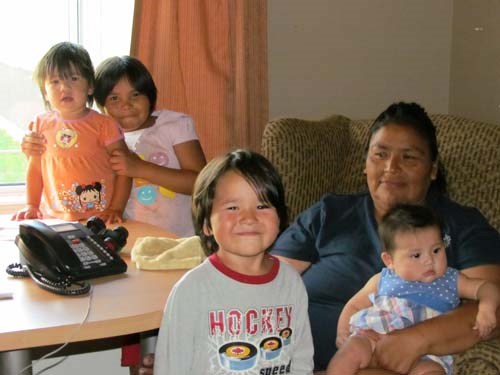The flooding caused by run-off and heavy rain has been well-documented over the past few months. We've heard the stories of flooded basements, the Provincial Disaster Assistance Programs, the challenges faced by farmers, and the visitations of various political figures to our area to discuss the situation. But what is not generally known is the disaster that befell families right on our own doorstep, at White Bear First Nation, and that for some people the situation has not yet been resolved.
Wanda Lonechild sits at a table in the foyer of the Four Nations Care Lodge. There is a look of frustration in her eyes, sometimes tears forming as she speaks about the ongoing nightmare she and her extended family face. Across from her is Chrissy Shepherd, also deeply impacted by the flooding, equally frustrated by delays in resolving their situation. The two women and their families were evacuated from their homes in March, as water from the rising water table flooded basements, crawl spaces and foundations.
For these women, the recent flooding was just another chapter in an ongoing battle against dampness and mould, a seemingly endless cycle of reporting housing challenges, seeing renovations 小蓝视频 made, only thereafter to witness and experience the return of the problem that plagues so many older houses on and off the reserve. According to the women, there are health issues directly contributable to the situation, and they say letters from the public health nurse, doctors and paediatricians verify this claim.
For Chrissy Shepherd it is a tragedy, she has four children, with ages ranging from seven years to 16 months, and two of them have respiratory conditions. In Wanda Lonechild's household there are young children too, and once again there's the concern that an impact on health is possible. And it was not just water that rose into the basement at the Lonechild home, it was raw sewage too.
That is why these two families were evacuated from their homes in March. When daily pumping of water from the properties hardly addressed the problem, they were moved to the Care Lodge. "When we were moved here, we were told it would only be for two weeks" the women say, but that was five months ago, and their extended families are still here, still in limbo, still deep in frustration that borders upon despair. It all comes down to a reality everyone can identify with, no matter how good the temporary accommodation, there's no place like home, and these families are ready to be in their own places again.
But they are not alone. According to Corrine Shepherd, Housing Director at White Bear First Nation, the flooding this year caused critical damage to 24 houses. Some families went to stay with relatives, some went to the Care Lodge and then to other places, and some are still living in the houses because they did not want to move out, no matter what. It is a local human tragedy.
For White Bear First Nation this situation stretches manpower and financial resources to the limit.
"We have been using our own funds" says Corrine Shepherd, "But 24 houses is a lot of property to get to."
Back at the Lodge, the answer "There is no money" does not sit well with Lonechild and Shepherd, hoping that soon their exile in the Lodge will be over.
The Housing Director sheds more light on the situation. "We have been in touch with the Provincial Disaster Assistance Program" she says, "They came out for last year's flooding, but we have not received the package from them. They say it was mailed a few weeks ago, but it is not here yet." She also explains they have not been back out to look at the damage from this year, not totally unexpected since that agency too, has had resources stretched by the extent of the flooding across the prairies.
Health Inspectors have been called to the area. Wanda Lonechild displays a report, received on July 26, from Health Protection and Public Health in Fort Qu'Appelle. In typical understatement it says "Surface water is entering the home's basement." However, it does go on to say "Extensive mold growth throughout the dwelling" and "Large amount of visible mold." The report also recommends "Clean up should be conducted by trained maintenance personnel. No one other than the clean up crew should be in the area." Environmental Health Officer Lorne Willits also recommended a number of lifestyle changes at the residence to improve the flow of clean air, including the use of dehumidifiers.
So is there good news for the two families still living at the Lodge? "They are not going to be there forever" says the Housing Director, and she indicates a possible timetable of the Fall for their location, depending on available finances. Perhaps the good news is that the Care Lodge is available. No, it is not home, but right now it is better than nothing, and certainly provides a respite from the health-impacting condition of their homes. So for now they stay there, balancing frustration for the present with hope for the future, the hope that this time renovations will somehow address the dampness issue fully, and permanently.




